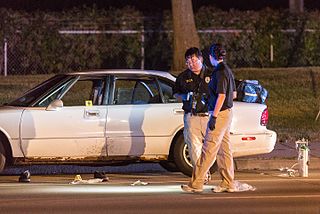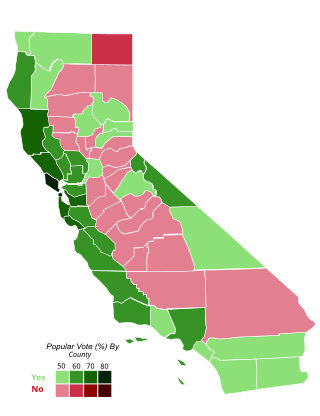Burglary, also called breaking and entering (B&E) and housebreaking, is the act of illegally entering a building or other areas without permission, typically with the intention of committing a further criminal offence. Usually that offence is theft, larceny, robbery, or murder, but most jurisdictions include others within the ambit of burglary. To commit burglary is to burgle, a term back-formed from the word burglar, or to burglarize.
A violent crime, violent felony, crime of violence or crime of a violent nature is a crime in which an offender or perpetrator uses or threatens to use harmful force upon a victim. This entails both crimes in which the violent act is the objective, such as murder, assault, rape and assassination, as well as crimes in which violence is used as a method of coercion or show of force, such as robbery, extortion and terrorism. Violent crimes may, or may not, be committed with weapons. Depending on the jurisdiction, violent crimes may be regarded with varying severities from homicide to harassment. There have been many theories regarding heat being the cause of an increase in violent crime. Theorists claim that violent crime is persistent during the summer due to the heat, further causing people to become aggressive and commit more violent crime.
In the United States, habitual offender laws have been implemented since at least 1952, and are part of the United States Justice Department's Anti-Violence Strategy. These laws require a person who is convicted of an offense and who has one or two other previous serious convictions to serve a mandatory life sentence in prison, with or without parole depending on the jurisdiction. The purpose of the laws is to drastically increase the punishment of those who continue to commit offenses after being convicted of one or two serious crimes.
A home invasion, also called a hot prowl burglary, is a sub-type of burglary in which an offender unlawfully enters into a building residence while the occupants are inside. The overarching intent of a hot prowl burglary can be theft, robbery, assault, sexual assault, murder, kidnapping, or another crime, either by stealth or direct force. Hot prowl burglaries are considered especially dangerous by law enforcement because of the potential for a violent confrontation between the occupant and the offender.
Articles related to criminology and law enforcement.

National Incident-Based Reporting System (NIBRS) is an incident-based reporting system used by law enforcement agencies in the United States for collecting and reporting data on crimes. Local, state and federal agencies generate NIBRS data from their records management systems. Data is collected on every incident and arrest in the Group A offense category. These Group A offenses are 52 offenses grouped in 23 crime categories. Specific facts about these offenses are gathered and reported to NIBRS. In addition to the Group A offenses, 10 Group B offenses are reported with only the arrest information.

Crime in Sweden is defined by the Swedish Penal Code and in other Swedish laws and statutory instruments.
Delroy Easton Grant is a Jamaican-born British convicted serial rapist who carried out a series of offences of burglary, rape and sexual assault between October 1992 and May 2009 in the South East London area of England. Grant, also known as the Minstead Rapist and latterly the Night Stalker, is thought to have been active since 1990. He had a distinctive modus operandi, preying primarily on elderly women who lived alone. He is suspected of over 100 offences from 1990 to 2009.

A drug-related crime is a crime to possess, manufacture, or distribute drugs classified as having a potential for abuse. Drugs are also related to crime as drug trafficking and drug production are often controlled by drug cartels, organised crime and gangs. Some drug-related crime involves crime against the person such as robbery or sexual assaults.
Property crime is a category of crime, usually involving private property, that includes, among other crimes, burglary, larceny, theft, motor vehicle theft, arson, shoplifting, and vandalism. Property crime is a crime to obtain money, property, or some other benefit. This may involve force, or the threat of force, in cases like robbery or extortion. Since these crimes are committed in order to enrich the perpetrator they are considered property crimes. Crimes against property are divided into two groups: destroyed property and stolen property. When property is destroyed, it could be called arson or vandalism. Examples of the act of stealing property is robbery or embezzlement.
Victimisation is the state or process of being victimised or becoming a victim. The field that studies the process, rates, incidence, effects, and prevalence of victimisation is called victimology.

Crime in New Zealand encompasses criminal law, crime statistics, the nature and characteristics of crime, sentencing, punishment, and public perceptions of crime. New Zealand criminal law has its origins in English criminal law, which was codified into statute by the New Zealand parliament in 1893. Although New Zealand remains a common law jurisdiction, all criminal offences and their penalties are codified in New Zealand statutes.

Crime in Minnesota encompasses a wide range of unlawful activities that occur within the state, regulated by both state and federal laws. While crime rates in Minnesota are generally below the national average, certain areas and types of crime have garnered public attention.

Crime in Finland is combated by the Finnish police and other agencies.

Proposition 47, also known by its ballot title Criminal Sentences. Misdemeanor Penalties. Initiative Statute, was a referendum passed by voters in the state of California on November 4, 2014. The measure was also referred to by its supporters as the Safe Neighborhoods and Schools Act. It recategorized some nonviolent offenses as misdemeanors, rather than felonies, as they had previously been categorized.
Crime in the Australian Capital Territory is controlled by ACT Policing, which is responsible for providing policing services to the Australian Capital Territory (ACT). Prisons are managed by ACT Corrective Services.
Jailbirds is an American reality television series about female inmates at the Sacramento County Jail, California, which premiered on Netflix in 2019. It documents the lives of female inmates of Sacramento County Jail in California, which has just under 2,400 inmates. The show aired a single season with six episodes in 2019, revealing to the audience various prisoners dealing with the reality of "their life being turned upside down" in jail as expressed by executive producer Drachkovitch when questioned on the prison environment. The production focused on aspects of prison life including violence, isolation and newfound relationships.
Joseph McCann is an English serial rapist. In April and May 2019, McCann committed sexual attacks in Hertfordshire, London, Greater Manchester and Cheshire against 11 strangers, ranging in age from an 11-year-old boy to a 71-year-old woman. He evaded police, who suspect that he was sheltered by a "support network" across the country. For these crimes, he was tried at the Old Bailey and, on 6 December, convicted of 37 offences. Three days later, he was given 33 life sentences.

Zoe Progl was a British criminal. Born into a poor family and with a father who was often drunk and in trouble with the police, Progl began stealing to feed herself from the age of six. She later progressed to shoplifting and worked in nightclubs where she fraternised with criminals. Progl married an American soldier at the age of 18, but soon left him and began carrying out burglaries with a new partner. Whilst three months pregnant, she was sentenced to three years detention at Aylesbury Borstal. After her release, she had an affair with Tommy "Scarface" Smithson, a London gangster whose gang included the Kray twins. She had a second child with Smithson before he left her.
George Henry "Taters" Chatham was a British thief and burglar. Born to a middle-class family, he aspired to become a professional footballer but despite a trial at Queen's Park Rangers, nothing came of it. Chatham turned to crime and was first convicted of theft in 1931. By the end of that decade he was burgling the houses of wealthy Londoners, carefully selecting his targets from society magazines. His calm-headedness led to his nickname from the Cockney rhyming slang for cold.








